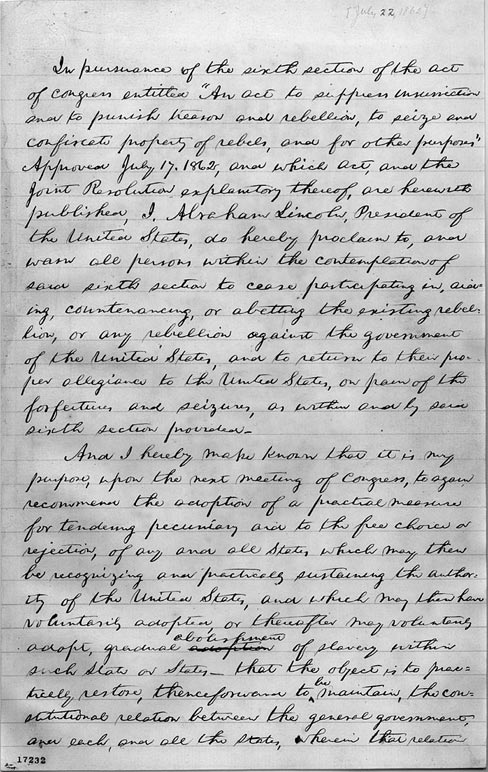Media Review
Abraham Lincoln Papers at the Library of Congress
http://memory.loc.gov/ammem/alhtml/malhome.html
Maintained by the Library of Congress; accessed on September 24-26, 2007
The Abraham Lincoln Papers at the Library of Congress consists of approximately 20,000 items associated with the life and career of the nation's 16th president, including incoming and outgoing correspondence and enclosures, drafts of speeches, and notes and printed material.(1) The collection consists of three series of documents, the first of which—and the core of the collection—was preserved by Lincoln's son Robert Todd Lincoln, who deeded it to the Library of Congress in 1923. The remaining two series consist of documents retained by John G. Nicolay, secretary to Lincoln during his presidency, which became part of the Papers in 1959, and a group of documents acquired independently by the Library of Congress.
Most of the documents in the Abraham Lincoln Papers date from the 1850s through Lincoln's presidency (1861-1865), although the earliest dates from 1833 and the latest from 1916. Their importance ranges from Lincoln's draft of the Emancipation Proclamation—arguably one of the greatest documents in human history—to relatively inconsequential correspondence from admirers. The website notes that the papers "are characterized by a large number of correspondents, including friends and associates from Lincoln's Springfield days, well-known political figures and reformers, and local people and organizations writing to their president."
In its online presentation, the Abraham Lincoln Papers is made available to researchers as approximately 61,000 facsimile (grayscale digital) images of documents scanned from microfilm copies of the collection made in 1947. These images are supplemented by 10,000 linked transcriptions created by scholars at the Lincoln Studies Center at Knox College in Galesburg, Illinois. The collection is searchable by keyword and browsable by series, each of which is arranged chronologically.
In general, the quality of the digital images is quite good, especially given the fact that the images were created, not from the original documents that the Library of Congress considered too fragile to digitize, but from a 1947 microfilm produced according to early and less than ideal standards. Users can download the images for further study.
 |
The Manuscript Division at the Library of Congress preserves President Lincoln's first draft of the Emancipation Proclamation dated July 22, 1862. (Courtesy of the Library of Congress.) |
The documents transcribed by the project editors are either historically important or representative of the president's unsolicited incoming mail. Transcriptions are available for all documents in Lincoln's own hand and secretarial copies of Lincoln documents. Transcriptions also exist for approximately 50 percent of the other documents in the collection. Many of the transcriptions include annotations with contextual information on people and issues mentioned in the documents. Project editors have provided extensive background information on the transcription project and its procedures.
At the time of this review, the website had two special presentations on the Emancipation Proclamation and the Lincoln assassination that combine short narratives and timelines of each event, images of related documents from the Abraham Lincoln Papers, and supplemental images from other Library of Congress collections. Each presentation provides a concise introduction to these pivotal moments in Lincoln's life. For users who want to explore the life and times of Abraham Lincoln further, the website offers links to related Library of Congress and external websites. The site also provides bibliographies on Lincoln himself and the Papers.
The Abraham Lincoln Papers at the Library of Congress is an excellent resource for Abraham Lincoln scholars and enthusiasts. Scholars will appreciate the website's search capabilities, and casual users will enjoy the presentations. Additional illustrated special presentations that draw on images from the Papers and other Library of Congress collections would definitely enhance the site. A general introduction to Lincoln's life and career would be especially useful for elementary and high-school students and general readers just beginning to learn about Lincoln's life and contributions to society. Special presentations aside, the site effectively helps advance the goal of the National Digital Library Program at the Library of Congress "to offer broad public access to a wide range of historical and cultural documents as a contribution to education and lifelong learning."
Terry Tatum
Chicago Department of Planning and Development, Landmarks Division
Note
1. The Abraham Lincoln Papers at the Library of Congress website was a collaborative effort of the National Digital Library Program and the Manuscript Division at the Library of Congress, the Lincoln Studies Center at Knox College in Galesburg, Illinois, and Online Computer Library Center, Inc., of Bethlehem, Pennsylvania. Donald G. Jones, Terri L. Jones, and the Jones Family Foundation provided financial support for the project.
